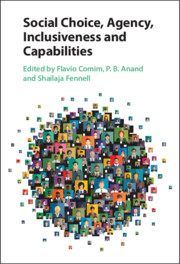Book contents
- Social Choice, Agency, Inclusiveness and Capabilities
- Social Choice, Agency, Inclusiveness and Capabilities
- Copyright page
- Contents
- Figures
- Tables
- Contributors
- Preface and Acknowledgements
- 1 Introduction: social choice, agency, inclusiveness and capabilities
- Part I Social Choice and Capabilities
- Part II Inclusiveness, Social and Individual Agency
- Part III Social Choice and Capabilities in Action
- 14 Measuring the independence of ‘dependent’ persons based on the capability approach
- 15 Indigenous challenges to the capability approach
- 16 Situating the family within the capabilities framework: a collective conversion factor
- 17 An ethical perspective on the United Kingdom’s Improving Lives: The Future of Work, Health and Disability
- 18 Public services as conversion factors
- Index
- References
17 - An ethical perspective on the United Kingdom’s Improving Lives: The Future of Work, Health and Disability
from Part III - Social Choice and Capabilities in Action
Published online by Cambridge University Press: 28 March 2024
- Social Choice, Agency, Inclusiveness and Capabilities
- Social Choice, Agency, Inclusiveness and Capabilities
- Copyright page
- Contents
- Figures
- Tables
- Contributors
- Preface and Acknowledgements
- 1 Introduction: social choice, agency, inclusiveness and capabilities
- Part I Social Choice and Capabilities
- Part II Inclusiveness, Social and Individual Agency
- Part III Social Choice and Capabilities in Action
- 14 Measuring the independence of ‘dependent’ persons based on the capability approach
- 15 Indigenous challenges to the capability approach
- 16 Situating the family within the capabilities framework: a collective conversion factor
- 17 An ethical perspective on the United Kingdom’s Improving Lives: The Future of Work, Health and Disability
- 18 Public services as conversion factors
- Index
- References
Summary
The headline aim of the UK governments ten-year strategy for work, health and disability is to have 1 million more disabled people in work by 2027. Good work can be health-enhancing, so there is a prima facie case for encouraging those with chronic health conditions and disabilities to work. The use of assistive technology could help improve their ability to work. However, disabled individuals may have greater difficulty in both accessing good work and having opportunities to improve their health. The concern is that disabled people who remain unable to work may find themselves stigmatized (as freeloaders), though their inability to work may be due to their greater difficulty in achieving sufficient health, or the medical assessment process, or both. These multidimensional barriers should be reflected in the strategys implementation, and valuing the agency of disabled people - respecting their choices in relation to working or not (and not blaming them if they choose not to work) - would increase their health more than the current strategy. The chapter suggests that the headline aim should really be to give 1 million more disabled people the opportunity to work by 2027.
Keywords
- Type
- Chapter
- Information
- Social Choice, Agency, Inclusiveness and Capabilities , pp. 385 - 400Publisher: Cambridge University PressPrint publication year: 2024

